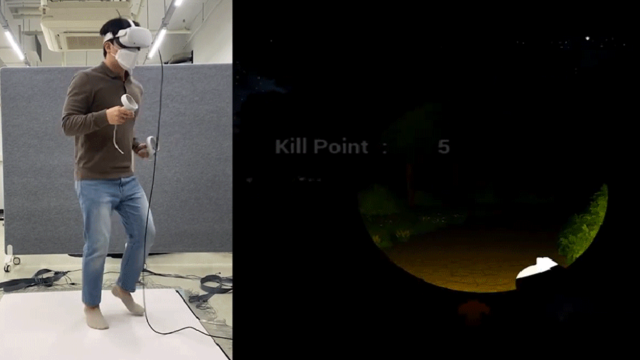Virtual reality headsets now come close enough to fooling your eyes into believing you’re someplace else, but the experience doesn’t translate as well to the rest of your body. Researchers from South Korea’s Gwangju Institute of Science and Technology want VR to be a whole body experience, and have created a way to physically walk and run around virtual worlds without actually going anywhere.
The ultimate goal for virtual reality is to have something like the Holodecks featured in Star Trek: The Next Generation, where users were free to navigate virtual worlds by actually walking around in them instead of having to control their movements using joysticks. But merging real world movements, like walking or running, with VR simulations has been one of the biggest challenges in the space. It’s a necessary advancement, though, as it won’t just make your experience more immersive, but will also help prevent motion sickness, which can rear its ugly head if your brain processes you moving and your body does not — this is very common with joystick controls in VR.
It’s a problem we’ve seen VR researchers tackle again and again. Over the years we’ve seen everything from elaborate treadmill-like platforms that can move in multiple directions under a user’s feet, to a completely mobile VR solution that swaps the real world for a computer-generated one while the user goes for a walk outside. After over a decade of development, a company called Virtuix is also finally delivering its solution, which has VR users standing in a large concave dish, allowing them to walk or run in place while their movements get translated to the virtual experience. But it’s a fairly large contraption demanding a sizable amount of floorspace, and at $US3,000 ($4,165), most VR users won’t be able to afford one.
Researchers from South Korea’s Gwangju Institute of Science and Technology have come up with a smaller and more affordable solution. By taking advantage of technology developed at MIT CSAIL, they’ve made a flexible foot-sensing mat reminiscent of the pads that shipped with the home versions of games like Dance Dance Revolution, but with far more sensitivity.
The Seamless-walk system uses MIT’s intelligent carpet technology to capture the user’s “high-resolution foot pressure imprints” as they stand, walk, and even run in place, on the mat. The data from the mat’s sensors are processed by a machine learning model that is able to not only differentiate the pressure from a user’s left and right feet, but extrapolate their intended movements and speed, whether they’re walking or running forwards or back, or simply turning from side to side. The mat replaces the need for a handheld joystick, as well as other hardware like body-mounted motion sensors or a camera base station.
Having users physically move their bodies to navigate a virtual world could be the key to reducing the motion sickness that many experience when strapping on a VR headset. If a VR character’s movements are gently bobbing from side to side as they’re walking, but the user’s brain isn’t detecting those same movements in the real world because the user is standing still and just moving a tiny joystick, that sensory separation can lead to confusion, dizziness, and even nausea. It’s one of the biggest things holding VR back from wider adoption, and alternate solutions likes teleporting characters or room scale VR can only go so far (about as far as your living room, in the case of the latter). But this foot-sensing mat could help make infinite movement options more accessible, because it could be mass-produced on the cheap, and can be easily rolled up and stored at the end of a VR session, unlike solutions where the hardware occupies a big chunk of floor space when not in use.
The obvious downside to the mat is that users don’t actually move around on it, and instead have to walk and run in place, which, as the video above demonstrates, could be easily confused for them impatiently waiting to use the bathroom.
The system could be scaled up, however, and a foot-sensing mat could be created that’s large enough to fill an entire warehouse, allowing VR users to more naturally walk and run around in real life, and in their virtual worlds, without being tethered to other hardware to detect their movements. But until we figure out how the Holodecks keep users from running into walls eventually, maybe the “I have to pee” dance approach is as good as it will get.

Leave a Reply